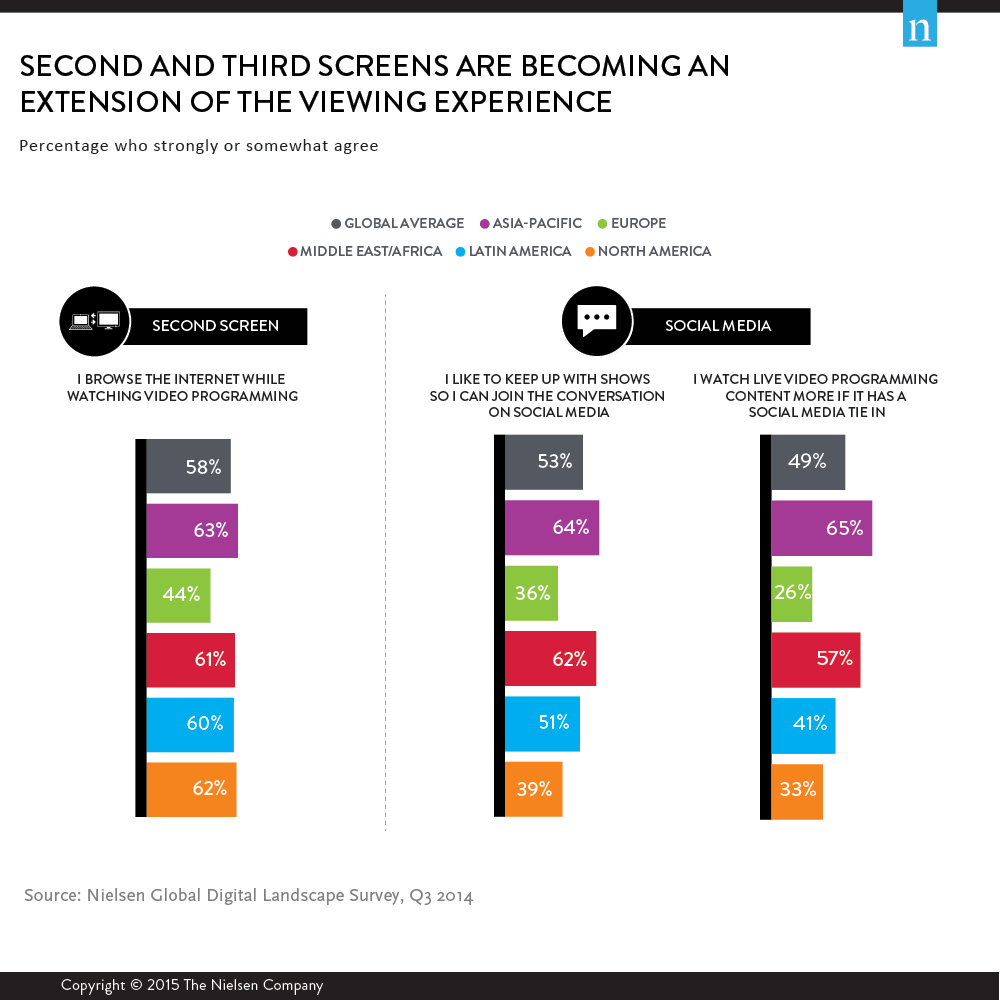From keeping tabs on friends via social media to skipping lines at the store by shopping online, technology continues to reshape our everyday habits. In fact, nearly seven-in-10 (69%) global respondents to a recent survey think face-to-face interactions are being replaced with electronic ones. And the digital landscape is only getting more crowded, as a new wave of digital devices, such as wearable and connected car technologies, gain traction.
Today, we have more control over when, where and how we watch video programming, but scheduled viewing hasn’t gone away for most of us. In fact, 65% of global respondents still prefer to watch video programming live at its regularly scheduled time. But more and more frequently, real-time conversations on social media are replacing physical gatherings around the water cooler to talk about a previous night’s episode of a favorite TV show. Not only does watching in real-time avoid spoilers, live TV has become a real-time social event that goes way beyond the confines of our living rooms. More than half of global respondents (53%) say they like to keep up with shows so they can join the conversation on social media, and nearly half (49%) say they watch live video programming more if it has a social media tie in. Forty-seven percent of global respondents say they engage with social media while watching video programming.
Regionally, Asia-Pacific and Africa/Middle East respondents are particularly engaged in social media while viewing, exceeding the global average for attitudes related to social media use. For example, 65% of Asia-Pacific and 57% of African/Middle Eastern respondents watch live programming if it has a social media content (compared with 49% globally). In addition, more than six-in-10 respondents in Asia-Pacific (64%) and Africa/Middle East (62%) say they like to keep up with shows so they can join the conversation on social media.
Using social media while watching video programming is only one example of second-screen usage, and many content providers are incorporating interactive multi-screen experiences for viewers. Getting ancillary content, researching information about characters, playing mobile games or reading/watching behind-the-scenes interviews are becoming common practices. More than half of global respondents (58%) say they browse the Internet while watching video programming.
“The second, third and sometimes fourth screen is becoming a fundamental extension of the viewing experience,” said Megan Clarken, executive vice president, Nielsen Global Watch Product Leadership. “While multiple screens give viewers more options, they also give content providers and advertisers more opportunities and ways to reach and engage with viewers. Well-designed experiences can not only make the viewing experience more enjoyable, but they maximize the time users spend interacting with brands, too.”

The report also discusses:
- How content is consumed in rapidly shrinking media boundaries.
- Device preferences by programming type and viewer activity.
- Digital expansion opportunities by generation.
For more detail and insight, download Nielsen’s Global Digital Landscape Report.
About the Nielsen Global Survey
The findings in this survey are based on respondents with online access across 60 countries. While an online survey methodology allows for tremendous scale and global reach, it provides a perspective only on the habits of existing Internet users, not total populations. In developing markets where online penetration has not reached majority potential, audiences may be younger and more affluent than the general population of that country. Additionally, survey responses are based on claimed behavior, rather than actual metered data.



